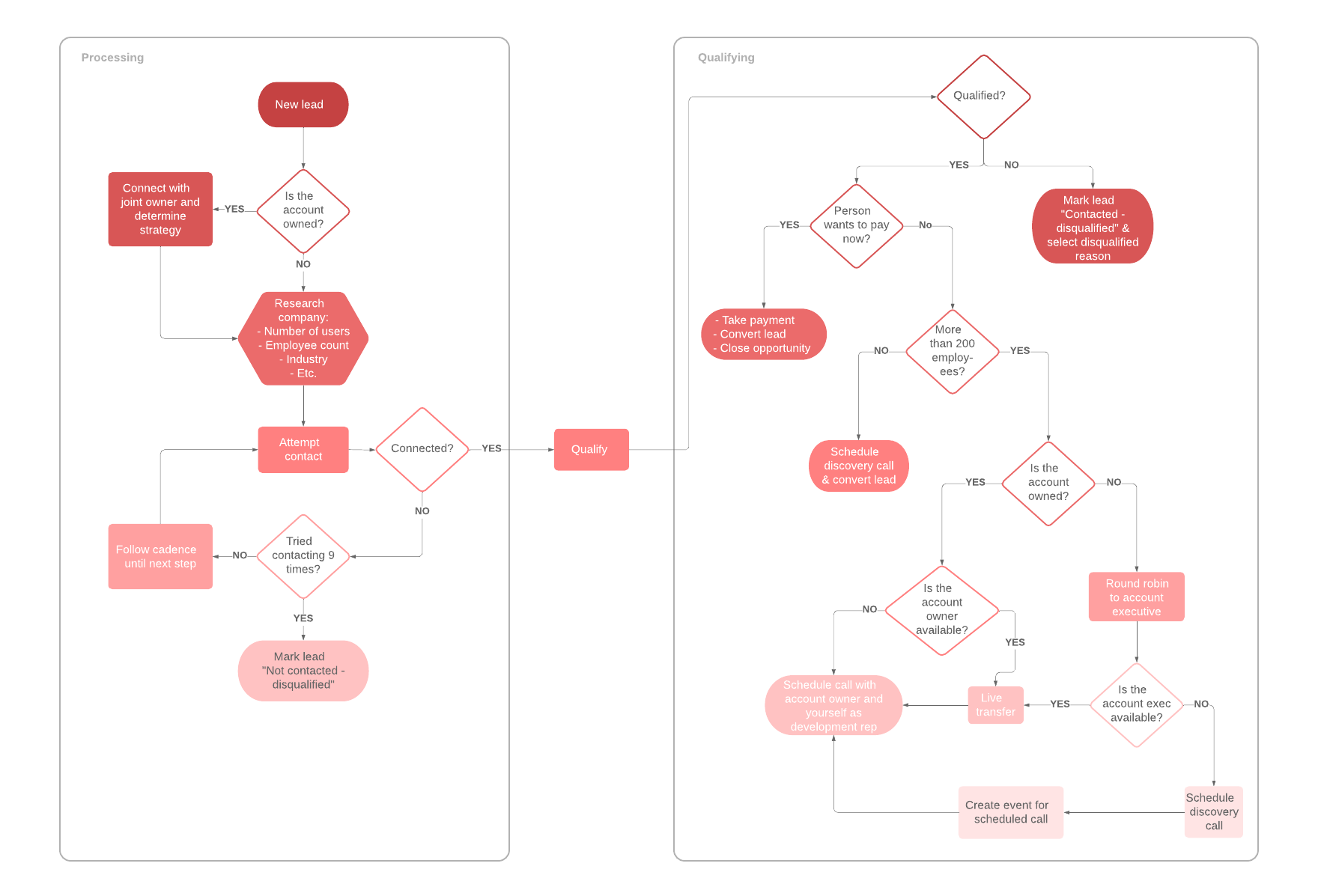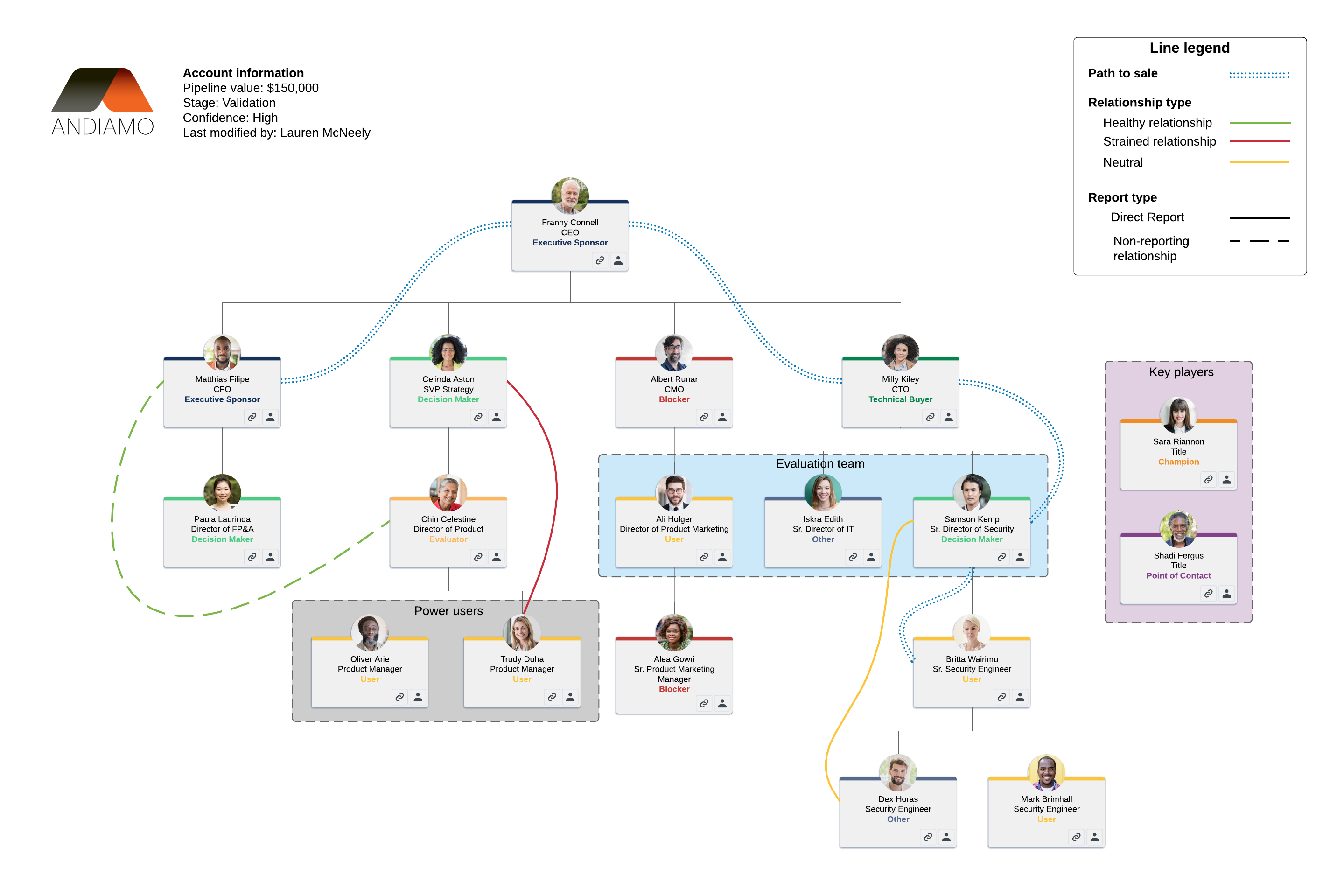
Sales prospecting tips: 5 advanced ways to improve your process
Lucid Content
Reading time: about 5 min
Topics:
Prospecting is the lifeblood of sales. It’s one of the most important aspects of bringing new customers—and revenue—into your business. But how do you start sales prospecting? What are the different types of prospecting? How can you ensure your prospecting strategy is effective? What’s the best process to use?
Before you head out on your next sales prospecting endeavor, take a look at five sales prospecting tips that can make you more successful.

What is sales prospecting?
Sales prospecting is the act of recruiting or seeking new customers for your organization, typically through cold calling or contacting cold nurture leads. One of the primary goals of sales prospecting is to create an interest in your product and turn that interest into a conversation (and eventually a sale or contract).
In Lucidchart, you can develop a process to determine which prospects are more or less likely to purchase your product or service. Start with our qualifying leads flowchart template.

Types of sales prospecting
Whether you’re new to the salesforce or are a seasoned salesperson, there are a few different types of sales prospecting methods you can leverage to build out your prospect list.
Cold calling and emailing
This is the number-one sales prospecting method and is one of the fastest ways for you to grow your prospect list. Cold calling gives you the chance to talk directly to people about how your product or service will benefit them.
To ensure successful cold calling, create a script that highlights the benefits of your product and includes answers to possible customer objections. A call script creates a framework for the call and ensures that you cover all important information. Don’t limit yourself to one form of cold calling. Take advantage of email, social media, and snail mail. A mixture of these techniques can increase the a prospect’s interest and give you a higher chance of converting leads.
Referrals and networking
This is another staple of the sales world and is one of the most effective forms of sales prospecting. Referrals get you in direct contact with warm leads and decision makers, which helps you grow your prospect list more quickly. Referrals can come from anywhere—past customers, existing customers, and prospects you couldn’t close. Each of these groups can help you get in contact with other potential prospects. You can network in various ways, like attending a trade show or keeping in contact with old friends and colleagues.
Remember, growing your prospect list through referrals and networking takes time. You have to establish a relationship with your prospects in order to earn their trust. This relationship comes by staying in contact and taking a genuine interest in your prospects. None of this happens in a day, so don’t be discouraged if you don’t see immediate results.
Social media
Take advantage of Facebook, Twitter, Instagram, Pinterest, and other social media platforms in your everyday sales prospecting as a way to grow your prospect list. Successful prospecting on social media also happens gradually. You can’t expect to have thousands of followers on Twitter or Instagram in just one day—your audience will grow gradually as you consistently post on these platforms.
These methods are an important part of growing your prospect list, but remember sales prospecting takes time. Don’t be discouraged if your first attempts at prospecting don’t go well. Stay in touch with your leads through social media or through LinkedIn—there may come a time when they need your product.
Don’t be afraid to mix up your process and take a different approach to any of the methods mentioned above. Figure out what approach and method works best for you and your audience.

Transform your B2B sales pipeline with this social selling framework.
Learn moreTips for sales prospecting
Once you have optimized your customer prospecting process and allocated your resources to the right place, it’s time to begin your outbound tactics. Below are five tips for successful sales prospecting:
1. Identify decision-makers
You want to focus your attention on the people who actually make decisions, which means you’ll need to do your homework before contacting the company. Take a look at this sales account map from Lucidchart to help you identify positions of power within an organization.

2. Become a product expert
Your customers need to feel that you know your products or services inside and out and can easily identify which product or service will benefit their business the most. By becoming an expert on your product, you’ll be able to pinpoint which audiences and industries you should be reaching out to.
3. Establish consistent processes
As previously mentioned with the qualifying leads flowchart, you want to ensure that you’re focusing your attention on the decision makers. To help you navigate through your prospect list, you need to have a consistent process in place. This process should involve determining if a person is a decision maker and determining next steps from there. If they are the decision maker, then you can continue down the sales path. If not, do some more research to see who you should be contacting.
4. Grow your prospect list
You can never too many prospects, nor can you spend too much time prospecting. Set aside time each day to prospect and grow your contact list. Choose the prospecting strategy that works best for you. If you’re good at cold calling, cold call. If you’re not, focus your time on emailing or networking.
5. Show your value
To be successful in sales prospecting, you need to show your prospects why they need you—not why you need them. There are a number of different ways you can demonstrate your value during the sales prospecting process, including showing the to-be process once the organization implements your product or service, highlighting best practices, and keeping your customers focused on the benefits that will come from doing business with you.
By following these tips, you’ll be more effective in bringing new customers into your organization, and you’ll become more confident in your sales prospecting skills. Whether you’re just starting to grow your sales prospect list or have plenty of experience under your belt, these tips can help you grow your list faster and turn prospects into actual customers.
It takes a lot of work to find the right prospects—but you still want to ensure that every potential customers has a great buyer experience.
Learn howAbout Lucidchart
Lucidchart, a cloud-based intelligent diagramming application, is a core component of Lucid Software's Visual Collaboration Suite. This intuitive, cloud-based solution empowers teams to collaborate in real-time to build flowcharts, mockups, UML diagrams, customer journey maps, and more. Lucidchart propels teams forward to build the future faster. Lucid is proud to serve top businesses around the world, including customers such as Google, GE, and NBC Universal, and 99% of the Fortune 500. Lucid partners with industry leaders, including Google, Atlassian, and Microsoft. Since its founding, Lucid has received numerous awards for its products, business, and workplace culture. For more information, visit lucidchart.com.
